Want to grow your business smarter? Automating Customer Lifetime Value (CLV) segmentation helps you target the right customers, save time, and boost revenue. Here's the key:
- What is CLV? It's the total revenue a customer is expected to bring over time, including purchases, referrals, and engagement.
- Why automate it? Manual processes are slow, error-prone, and outdated. Automation tools like Hatrio Sales provide real-time insights, fewer errors, and dynamic updates for better decision-making.
- How does it work? By tracking purchase history, engagement, retention rates, and costs, automated tools calculate CLV and segment customers into actionable groups.
- What can you do with it? Identify high-value customers, design targeted campaigns, and improve retention with data-driven strategies.
Automation simplifies CLV analysis, helping you focus on what matters - building stronger customer relationships and driving growth.
CLV Automation Basics
CLV Calculation Elements
To calculate Customer Lifetime Value (CLV) effectively, it's essential to track specific data points throughout the customer journey. These include:
- Purchase History: Details like transaction amounts, frequency, and timing.
- Customer Engagement: How customers interact across various channels.
- Acquisition Costs: Expenses tied to marketing and sales efforts for each customer.
- Service Costs: Costs related to customer support and maintenance.
- Retention Rate: How long customers stick around.
- Referral Value: Revenue gained from customer recommendations.
By continuously monitoring these metrics, automation tools provide accurate, real-time CLV segmentation.
Manual CLV Process Limitations
Manual CLV calculations often fall short for several reasons:
- Time-Consuming: Gathering and analyzing data manually can take weeks.
- Prone to Errors: Complex calculations across spreadsheets increase the likelihood of mistakes.
- Outdated Insights: By the time the analysis is done, the data may no longer be relevant.
- Scaling Issues: Handling large customer databases manually is inefficient.
- Inconsistent Updates: Irregular updates can lead to missed opportunities.
- Resource-Heavy: Staff spends excessive time on repetitive tasks instead of focusing on strategic goals.
How Software Improves CLV Analysis
Automation platforms, like Hatrio Sales, solve these challenges and streamline CLV analysis with advanced features:
- Real-Time Processing: Automation tools process data continuously, enabling quick responses to shifting trends.
- Advanced Lead Scoring: These platforms assess customer potential using multiple factors, helping sales teams prioritize leads more effectively.
- Seamless Integration: They connect directly with existing tools, managing everything from prospecting to closing deals.
- Data Accuracy: Automated systems verify and update customer data, pulling information efficiently from sources like LinkedIn.
Hatrio Sales, trusted by over 104,000 websites, highlights how automation can transform CLV analysis.
Implementing and Training Predictive Customer Lifetime Value Models
Setting Up CLV Automation
Getting your CLV automation set up correctly ensures your segmentation delivers insights you can act on.
Preparing Your Data
Before diving in, make sure your data is clean and organized. Focus on these areas:
- Transaction Records: Include complete purchase histories with amounts and dates.
- Customer Demographics: Ensure contact details, locations, and business information are up to date.
- Interaction History: Log support tickets, engagement metrics, and communication records.
- Cost Data: Include customer acquisition costs and service-related expenses.
Standardize all records for US formats, such as dates, currency, phone numbers, and addresses.
Integrating CLV Automation with Your CRM
To connect your CLV automation tools with your CRM, careful setup is key. Hatrio Sales simplifies this process with its integration features:
-
API Configuration
- Establish secure API connections between your systems.
- Enable automatic data synchronization for seamless updates.
-
Data Mapping
Match key fields between your CRM and the automation tool, such as:- Customer IDs
- Purchase histories
- Communication logs
- Engagement metrics
- Lead scores
-
Automation Rules
Set up rules to trigger specific actions based on customer behavior and CLV thresholds.
Once integrated, validate your model to ensure it’s functioning as expected.
Testing Your CLV Model
Follow these steps to test your model:
-
Start Small
Run tests with 10-15% of your customer base to identify issues without disrupting your operations. -
Verify Accuracy
Compare automated CLV calculations with manually computed results for a sample group. -
Track Performance
Monitor critical metrics, including:- Data sync speed
- Calculation accuracy
- System response time
- Error rates
- Data consistency
"I'm using Hatrio Sales to find email addresses for outbound sales & Email Campaign. Our sales funnels are fully managed by them - from prospecting to qualifying to closing sales." - Dinakar Sakthivel, Hatrio Sales Platform Demo on Vimeo
sbb-itb-b22f30c
Using CLV Segments Effectively
Use your CLV segmentation data to fuel business growth and make smarter decisions.
Identifying Key Customer Groups
Pinpointing your most important customers lets you allocate resources where they'll have the biggest impact. Break customers into segments based on:
- Purchase Frequency: How often they buy and their order intervals.
- Average Order Value: The size of their transactions over time.
- Customer Longevity: How long they've been with your business.
- Engagement Level: Their interactions with your platform and communications.
By ranking customers with these metrics, you can create detailed profiles of your top-performing groups. With enriched data, you’ll also find it easier to spot similar prospects. These insights set the stage for campaigns tailored to each audience.
Designing Targeted Campaigns
Turn CLV insights into precise marketing strategies.
Tailored Messaging
- Adjust communication frequency based on how engaged they are.
- Personalize offers to align with their past purchases.
- Match content complexity to the preferences of each segment.
These tactics integrate seamlessly into automated campaign systems.
| CLV Segment | Campaign Focus | Communication Frequency |
|---|---|---|
| High Value | Premium services, early access | Weekly touchpoints |
| Mid-Tier | Cross-sell opportunities, rewards | Bi-weekly updates |
| Growing | Educational content, upgrade paths | Monthly newsletters |
Boosting Customer Retention
Use CLV data to craft retention strategies that keep customers coming back.
Stay Proactive
Track engagement patterns automatically to spot:
- Drops in usage frequency.
- Shifts in buying behavior.
- Reduced interaction with your outreach.
Retention Tactics by Segment
1. High-Value Customers
Offer exclusive perks and priority support. Set up alerts to flag changes in their behavior for quick action.
2. Growth Potential Segments
Launch nurture campaigns with educational resources and personalized upgrade suggestions based on their activity.
3. At-Risk Customers
Activate re-engagement campaigns if you notice signs like fewer purchases or longer gaps between orders.
These targeted efforts help you retain customers by addressing their specific needs and behaviors.
CLV Automation Tips
Having clean, reliable data is the backbone of accurate CLV segmentation.
Data Quality Management
Data Verification:
- Validate customer contact details.
- Remove duplicate entries and standardize formats.
- Enrich profiles with verified business information.
Use automated checks to ensure incoming data meets quality standards:
| Data Element | Quality Check | Action Required |
|---|---|---|
| Contact Info | Validate email format | Flag invalid formats for review |
| Purchase History | Ensure transaction completeness | Flag missing critical fields |
| Engagement Data | Verify activity timestamps | Remove corrupted records |
Once your data is clean and accurate, regular updates will help maintain and improve your automation processes.
Regular System Updates
Weekly Tasks:
- Review data import logs for errors.
- Check how segmentation rules are performing.
- Update customer scoring models as needed.
Monthly Tasks:
- Analyze changes in segment distributions.
- Adjust automation rules based on trends.
- Validate scoring criteria to ensure accuracy.
Quarterly Tasks:
- Recalibrate CLV calculations for better precision.
- Update insights on customer behavior patterns.
- Fine-tune segmentation thresholds for optimal results.
Human Review Process
Automated checks are powerful, but adding a human review ensures even greater accuracy in your segmentation.
Key Review Checkpoints:
- Segment Transitions: Keep an eye on unexpected shifts in customer segments. These could signal real changes or potential data issues.
- Outlier Detection: Set alerts for unusual patterns, like spikes in purchase frequency, engagement, or CLV scores.
- Model Validation: Compare automated results with manual analysis, incorporate customer feedback, and confirm that automated decisions align with your business goals.
Conclusion
Automating CLV segmentation can completely change how businesses manage customer relationships. By analyzing customer lifetime value (CLV), companies can pinpoint their most profitable customers, build loyalty, and allocate resources more effectively.
When done right, this approach helps sales teams focus on the best leads, increase conversions, and strengthen customer connections through tailored campaigns.
Here’s how you can make the most of CLV segmentation automation:
- Integrate Your Data: Sync your customer data with the automation system to ensure accurate insights.
- Define Segments: Use CLV calculations to create actionable customer groups.
- Automate Campaigns: Launch targeted drip campaigns for each segment to drive engagement.
- Monitor Results: Regularly review performance and tweak automation rules as needed.
These steps help connect your current data to a more efficient, automated CLV workflow.
For a seamless solution, Hatrio Sales offers tools like lead enrichment, automated scoring, and campaign management. These features make it easier for businesses to adopt and expand CLV segmentation strategies effectively.



